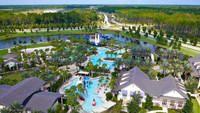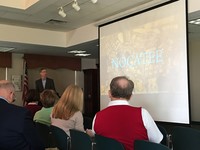

The uniting theme of a meeting of the Ponte Vedra Beaches Coalition on Monday was the idea that no one has a perfect understanding of the future — not even Nocatee.
Though Nocatee’s master developers, the PARC Group, spent years researching and planning for the community, no one could predict how the county would change around the neighborhoods. There is no denying that this planning contributed in a major way to Nocatee’s success, as it continues strong as the United States’ third best-selling community.
However, according to Greg Barbour, Chief Operating Officer and Partner at the PARC Group, some of the decisions that the developers made 15 years ago during planning may not be a perfect fit for the community’s future growth.
Barbour spoke to those gathered for a PVBC meeting on Monday at the Ponte Vedra Branch Library, with the goal of updating attendees on the growth of Nocatee and the reasoning behind its proposed New Town comp plan amendment.
“New Town is a land use category created about 15 years ago,” Barbour explained. “When we first started Nocatee, we found that St. Johns County didn’t have a land use category that fit with what we were going to do. Developments that would use New Town would have to follow very specific development standards.”
Some of these standards currently in place include a major commitment to parks and conservation, with at least 35 percent of total development area put into preservation, with pedestrian, bike and greenway trails. Other standards deal with creating a unified signage plan and standard street sizes.
The vital parts for the amendment, however, deal with the ratio of residential, office, retail and commercial spaces within New Town developments. The ratios are currently set in stone, and dictate strict rules about the makeup of businesses and homes within each community.
“We are not asking for any new or additional development rights,” Barbour explained. “Adjustments to the plan would provide us with flexibility in case the market does not end up in Nocatee.”
One change in the request would reduce the minimum multi-family percentage of total residential units from 20 percent to 5 percent. Nocatee currently offers 400 condos and units with more planned for the future, but would prefer to shift towards smaller single-family homes that offer high density and moderate price points. This would allow it to shift focus away from creating more multi-family housing units, such as apartments or condos.
The second major change would include allowing existing retail and office development in or within a three-mile radius of the community to be included in meeting the minimum standard for these uses. Retail in Nocatee, Barbour said, will ultimately be sized to meet residents’ demands. The development was never envisioned as one that would accommodate a regional retail center, with “big box” users like Walmart and Target.
Both of these major requests reflect market shifts as a result of two new developments in the area along the I-95 corridor: Durbin National and Twin Creeks – both of which have been approved for a significant amount of non-residential development.
“We think these are great developments,” Barbour said, “but they have changed the landscape.”
Both Durbin National and Twin Creeks have a strong focus on retail and office space — which is why Nocatee hopes to be granted approval to continue to focus on its strength: retiree- and family-geared residential communities.
Durbin National will offer 2.8 million square feet of office space, 2.4 million square feet of retail space, and 999 apartment units. Bass Pro Shops is one example of a large retailer already planned for the development. Nearby, Twin Creeks, at CR-210 and I-95, is approved to offer 700,000 square feet of office space, 1 million square feet of retail space and 2 million square feet of industrial space.
In the end, the amendments Nocatee is requesting seek to adapt to a new market — one that will soon include more major retailers, multi-family housing options and industrial/office space just down the road.
“Nocatee is about 40 percent built out,” Barbour said. “There’s another 20 to 25 percent that is under planning or design. There’s really only about 35 percent left for the marketplace — and that is what we’re looking at.”
Barbour also fielded questions from the audience, stating that Nocatee has sold land to an assisted living developer and have another “independent type living developer” looking at a parcel in the community.
He also said that there is a site planned for a drug store, but no solid commitment from any one retailer at this time.
“It’s all a function of when those drug store companies decide that the demographics are right for them,” Barbour said. “We do everything we can to get those type of commercial users in… We’re hoping a drug store will pop up in the near future.”